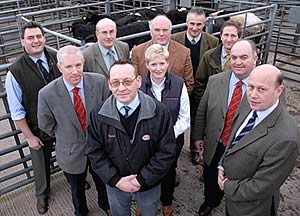 |
|||||||||
|
|||||||||||||||||||
|
|
Cumbria's Auction Marts Survive and Prosper Six years on from the start of the foot and mouth epidemic which devastated Cumbria’s livestock industry, auction markets in the county are selling more cattle and sheep through the market – at a greater turnover.
All of the county’s seven auction companies, some of which date back well over 100 years and operate 17 centres both in Cumbria and adjoining counties holding sales on every working day, have survived the difficulties to increase their share of the trade. The overwhelming support from stalwart livestock producers has resulted since 2001 in the building of a new market with another pending as well as the setting up of a new auction company. During 2006, throughput of all markets in England and Wales was 9.85 million sheep and 2.25 million cattle representing up to 60 per cent of prime lambs and 80 per cent of all breeding sheep sold and equating to a turnover of £1.1 billion. This is despite a decline in the number of markets from 210 in 1995 to 130 today. As a county, Cumbria has the greatest concentration of auction mart companies and it is this element of competition which has also helped them to survive. The importance of selling in the live ring has never been more apparent than since 2001’s foot and mouth crisis when lambs sold at all time low levels which had not been seen for generations and afterwards as the markets got going, prices increased by 35 to 45 per cent. Throughput since 2001 has increased each year highlighting that the service offered by auction marts to farmers is good and needed. Most recent figures show that in 2006 members of Cumbria Association of Livestock Auctioneers increased both turnover and throughput of stock in its Cumbrian marts, selling a total of 1.85 million head of livestock, worth £160.5 million compared with 1.64 million head sold worth £123.7 million in 2003. Prime cattle and prime sheep numbers sold through the ring have declined, mainly because of changes in agriculture such as declining numbers in the national beef herd and sheep flock resulting in fewer animals being finished. Cumbria Association of Livestock Auctioneers has warned producers of the perils of trading without the existence of marts to set the prices. “Some of our auction companies have been in operation for more than 130 years and are still going strong – but you only need to look at the situation the milk industry is in today with its abysmal milk prices to appreciate the importance of an open and competitive market,” said CALA’s chairman and Harrison & Hetherington auctioneer Robert Addison. “Rather than the buyer setting the price, the auction marts create competition, and equally importantly, the proceeds of the sales are guaranteed by the auction companies,” he added. “We can also provide feedback to the vendor – that is not only reflected in the prices they achieve but also in comment from buyers – and, if necessary, we can even follow up with how animals have done on the hook. “In areas which have lost auction markets, the biggest problem is that there is no competition for the wholesale buyers and the competition in the county also helps the livestock producers,” said Chris Dodds, Cumbria-based secretary of the Livestock Auctioneers’ Association, the umbrella organisation for auction markets, and a freelance auctioneer. Auctioneers in Cumbria believe they continue to attract loyal support from producers because:
Comments on behalf CALA’s member companies:Andrew Wright, manager of Ulverston Auction Mart,
which dates from 1877, and secretary of the Institute
of Auctioneers and Appraisers in Scotland, said: “I
would urge producers to support their local live mart and maintain
the competitive structure that auction marts provide.”
|
||||||||||||||||||

|
|
||||||||||||||||||
| home | agri-services | pedigree
pen | news | dairy | beef | machinery property | organisations | site map |
|||||||||||||||||||


